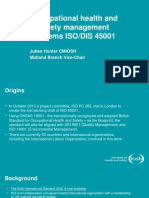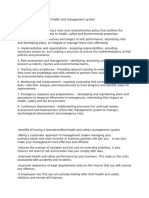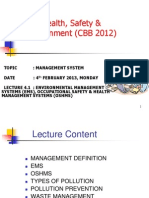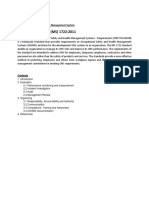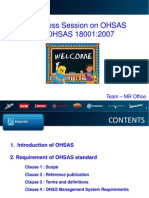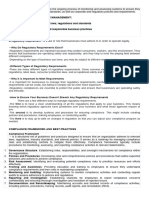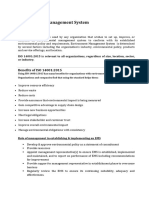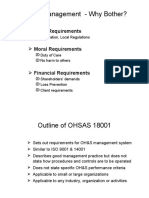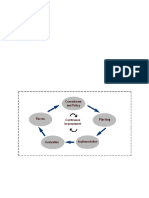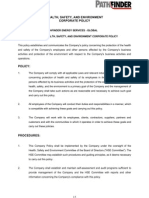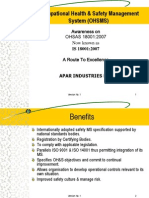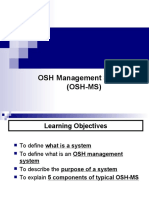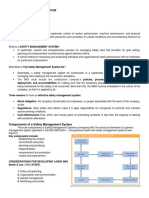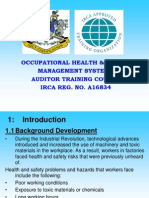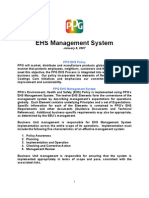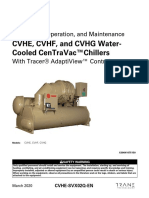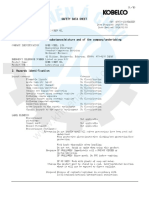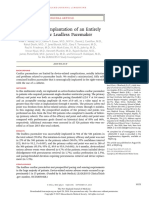0 ratings0% found this document useful (0 votes)
96 viewsChapter 2 Opm538
Chapter 2 Opm538
Uploaded by
Yuyu Comel1. The document discusses occupational safety, health, and environmental management systems (OSH/EMS). It outlines standards and frameworks like MS1722 and OHSAS 18000 that provide requirements and guidelines for managing risks, hazards, and legal compliance through a coordinated system.
2. An effective OSH/EMS involves developing policies, planning prevention activities, implementing controls, checking performance, and reviewing the system regularly. Benefits include a safer work environment, reduced costs from injuries, and improved business opportunities and reputation.
3. Key aspects of an OSH/EMS addressed are roles and responsibilities, training, documentation, monitoring, audits, compliance, corrective actions, and records management. Cert
Copyright:
© All Rights Reserved
Available Formats
Download as PDF, TXT or read online from Scribd
Chapter 2 Opm538
Chapter 2 Opm538
Uploaded by
Yuyu Comel0 ratings0% found this document useful (0 votes)
96 views3 pages1. The document discusses occupational safety, health, and environmental management systems (OSH/EMS). It outlines standards and frameworks like MS1722 and OHSAS 18000 that provide requirements and guidelines for managing risks, hazards, and legal compliance through a coordinated system.
2. An effective OSH/EMS involves developing policies, planning prevention activities, implementing controls, checking performance, and reviewing the system regularly. Benefits include a safer work environment, reduced costs from injuries, and improved business opportunities and reputation.
3. Key aspects of an OSH/EMS addressed are roles and responsibilities, training, documentation, monitoring, audits, compliance, corrective actions, and records management. Cert
Original Description:
CHAPTER 2 OPM538
Original Title
CHAPTER 2 OPM538
Copyright
© © All Rights Reserved
Available Formats
PDF, TXT or read online from Scribd
Share this document
Did you find this document useful?
Is this content inappropriate?
1. The document discusses occupational safety, health, and environmental management systems (OSH/EMS). It outlines standards and frameworks like MS1722 and OHSAS 18000 that provide requirements and guidelines for managing risks, hazards, and legal compliance through a coordinated system.
2. An effective OSH/EMS involves developing policies, planning prevention activities, implementing controls, checking performance, and reviewing the system regularly. Benefits include a safer work environment, reduced costs from injuries, and improved business opportunities and reputation.
3. Key aspects of an OSH/EMS addressed are roles and responsibilities, training, documentation, monitoring, audits, compliance, corrective actions, and records management. Cert
Copyright:
© All Rights Reserved
Available Formats
Download as PDF, TXT or read online from Scribd
Download as pdf or txt
0 ratings0% found this document useful (0 votes)
96 views3 pagesChapter 2 Opm538
Chapter 2 Opm538
Uploaded by
Yuyu Comel1. The document discusses occupational safety, health, and environmental management systems (OSH/EMS). It outlines standards and frameworks like MS1722 and OHSAS 18000 that provide requirements and guidelines for managing risks, hazards, and legal compliance through a coordinated system.
2. An effective OSH/EMS involves developing policies, planning prevention activities, implementing controls, checking performance, and reviewing the system regularly. Benefits include a safer work environment, reduced costs from injuries, and improved business opportunities and reputation.
3. Key aspects of an OSH/EMS addressed are roles and responsibilities, training, documentation, monitoring, audits, compliance, corrective actions, and records management. Cert
Copyright:
© All Rights Reserved
Available Formats
Download as PDF, TXT or read online from Scribd
Download as pdf or txt
You are on page 1of 3
CHAPTER 2
OCCUPATIONAL SAFETY, HEALTH, AND ENVIRONMENTAL MANAGEMENT
SYSTEM
OSH MANAGEMENT
- An integral part of the overall management system of an organization to manage the risks
associates with the business of the organization
OSH Standards MS1722
- Intended to address OSH rather than product and services safety
- Purpose of Standard:
1. To provide a system to protect employees from hazards and elimination of work-related
injuries, disabilities, ill health, diseases, near misses and fatalities
2. To establish a framework for OSH management system
3. To provide requirements on OSH management system with integration of OSH elements
with policy and management
4. To provide a means to motivate employers, management staff, employees and their
representatives in implementing OSH management principles with continual
improvement in OSH performance
Process of OSH Management System
OH & S Policy >> Planning >> Implementation & Operation >> Checking & Corrective Action >>
Management Review
Objectives of OSH Management System
1. OSHMS is a coordinated and systematic approach to managing health and safety risks
2. OSHMS helps organization to continually improved their safety performances and
compliance to health and safety legislation and standard
Benefit of OSH Management System
1. Helping organization creates safer work environment
2. Reducing injuries and injuries related costs
3. Improving business opportunities because customer is favoured to purchased product or
services from companies with an OSHMS
4. Providing measurable system to verify the OSH performance in the companies
5. Demonstrate the companies is meeting a legal requirement
6. Enhancing the organization reputation
Objective of OHSAS 18000
1. Developing an occupational health and safety policy for the organization
2. Establishing an occupational health and safety management system
3. Identifying the hazard, assessment of risks and risk control
4. Clarifying the legal and other requirement and evaluating compliances with them
5. Setting the occupational health and safety objectives and targets
6. Establishing programs for achieving the occupational health and safety objectives targets
7. Implementing and operation of the occupational health and safety management system
8. Evaluation of the occupational health and safety management system
Benefits of OHSAS 18001
1. Compliance with legal and other requirements
2. Employee satisfaction
3. Reducing of absenteeism
4. Reducing of work-related accidents and illness
5. Reducing of costs associated with accident and illness
6. Increasing of control of regulatory issues
7. Potentially reducing of insurance costs
Environmental Management System
- EMS is a system comprising of an organizational structure with its responsibilities, practices,
procedures, processes and resources for implementing and maintaining the system relating
to management of the environment
Manage implementation and operations of EMS by
1. Identifying roles, responsibilities and authorities
2. Providing adequate resources to implement the systems
3. Appointing management representative
4. Providing relevant training and awareness programs
5. Establish procedure to control internal and external communication with regards to EMS
and environmental aspects
6. Documenting your EMS which include:
-environmental policy, objectives and targets
-scope of EMS
-describe main elements of the EMS and how they interact with each other
-establish procedure to control your EMS documents
Check your EMS by
1. Establishing procedures to monitor and measure the key operational characteristics that
could have a significant impact on the environment
2. Ensuring that environmental monitoring and measuring equipment are calibrated and
verified, maintained and records are retained
3. Establishing a procedure to periodically evaluate compliance with all relevant legal
environmental requirements
4. Establishing procedure on managing actual and potential non-conformity and the corrective
and preventive actions
5. Establishing record control procedure for the EMS
6. Establishing internal audit procedure, conduct internal audit and report result to
management
EMS Legal and Other Requirements
1. Environmental Quality Act 1974 (Act 127) – to prevent, abatement, control of pollution and
environment. For any purposes related with that
2. Environmental Protection Act 1994 – to preserve environment
3. Occupational Safety and Health Act 1994 – to deal with OSH at workplace
4. Factory and Machinery Act (Act 139) – handling accident/diseases
5. Local Town Councils Regulations – local planning
Benefits of OSH Certification
1. Comply with legal requirements as specified in Occupational Safety and Health Act and other
relevant regulations
2. Fulfilling the business and social responsibility on environment management
3. Eliminate or minimize the risks to the employees and other people who may be exposed to
OSH risks associated with its activities
4. Safeguarding the business and provide the customer, supplier and stakeholders with
confidence because able to manage the OSH issues
5. Save more money because costs of preventing the OSH accidents are lesser than costs of
handling and corrective action after accidents occurs
6. Provide the competitive edge in market place because the system provides the continuous
improvement
7. Increase probability and business security
You might also like
- Heart of A Champion 2.0Document20 pagesHeart of A Champion 2.0Tom Williams100% (2)
- ISO 14001 Step by Step - A practical guide: Second editionFrom EverandISO 14001 Step by Step - A practical guide: Second editionRating: 5 out of 5 stars5/5 (1)
- Impaired MemoryDocument1 pageImpaired MemoryHarmony Grace0% (1)
- Cosmetics LectureDocument11 pagesCosmetics LectureShanice Langaman100% (3)
- Iso 9001-14001 Ims ManualDocument38 pagesIso 9001-14001 Ims ManualFarhan100% (2)
- Iso Dis 45001 PDFDocument46 pagesIso Dis 45001 PDFSeenivasagam Seenu100% (2)
- Topic 2 - Osh Management System (New)Document23 pagesTopic 2 - Osh Management System (New)AISYAH NABILAH ROSLANNo ratings yet
- Environmental Management Systems (EMS)Document13 pagesEnvironmental Management Systems (EMS)salman hussain100% (1)
- Implementation of ISO 14000 in Luggage Manufacturing Industry: A Case StudyDocument14 pagesImplementation of ISO 14000 in Luggage Manufacturing Industry: A Case StudyDevspringNo ratings yet
- 8 Elements of Successful Health and Management System Ig2 QUIZDocument5 pages8 Elements of Successful Health and Management System Ig2 QUIZCharl Ton A DalatenNo ratings yet
- Health, Safety & Environment (CBB 2012)Document25 pagesHealth, Safety & Environment (CBB 2012)nadia_shuhada_2No ratings yet
- Introduction To Ohs Management System Standards: Presenter: Zaikhasra Zainuddin 17 JULY 2009Document40 pagesIntroduction To Ohs Management System Standards: Presenter: Zaikhasra Zainuddin 17 JULY 2009Chandral VaradanNo ratings yet
- OSHMSDocument6 pagesOSHMSEmiliana BrendaNo ratings yet
- Ushine Media - Hse ManualDocument23 pagesUshine Media - Hse ManualZahid ImamNo ratings yet
- EMS SUSMITA LAHIRIDocument6 pagesEMS SUSMITA LAHIRIrizu7699dasNo ratings yet
- Health Safety & Environment: Management SystemDocument48 pagesHealth Safety & Environment: Management SystemElias Moussa100% (1)
- OHSAS PresentationDocument72 pagesOHSAS PresentationMahendraNo ratings yet
- Nebosh Igc Q/aDocument7 pagesNebosh Igc Q/amunawar100% (1)
- HSEManagementsystem PDFDocument48 pagesHSEManagementsystem PDFSyazreen ErinazNo ratings yet
- Nebosh Correct AnswersDocument10 pagesNebosh Correct AnswersCharl Ton A DalatenNo ratings yet
- OHSAS 18001 - Basis and Principles of Management Systems For Occupational Health and Safety - GCC Standardization OrganizationDocument3 pagesOHSAS 18001 - Basis and Principles of Management Systems For Occupational Health and Safety - GCC Standardization Organizationdanish_kabeerNo ratings yet
- Element 2 How Health and Safety Management Systems Work and What They Look LikeDocument16 pagesElement 2 How Health and Safety Management Systems Work and What They Look LikespkpalkuNo ratings yet
- QMS Lesson NotesDocument19 pagesQMS Lesson Notesmohamed said omarNo ratings yet
- Activity 14&15 MGMT 2Document4 pagesActivity 14&15 MGMT 2Ramil SalundagaNo ratings yet
- Hse MGNT PlanDocument9 pagesHse MGNT PlanmararijoelNo ratings yet
- Buks IDIP Unit D Assignment, Rev. 03Document43 pagesBuks IDIP Unit D Assignment, Rev. 03Saqib Rasool100% (5)
- Day2 ISO45001 REQUIREMENTS OF AN OCCUPATIONAL HEALTH AND SAFETYDocument15 pagesDay2 ISO45001 REQUIREMENTS OF AN OCCUPATIONAL HEALTH AND SAFETYJohn KingNo ratings yet
- T-MEET 412 MEE Module 1 Environmental Management SystemDocument24 pagesT-MEET 412 MEE Module 1 Environmental Management Systemkimbenedictaguilar19No ratings yet
- Chapter 7 Ohsas 18001Document100 pagesChapter 7 Ohsas 18001Apostrophe Fareez ImprezzaNo ratings yet
- GC1 Element 2 29dec 2019 New Syllabus Draft - v5Document18 pagesGC1 Element 2 29dec 2019 New Syllabus Draft - v5Mohamed AslamNo ratings yet
- Compliance Management Report 1Document3 pagesCompliance Management Report 1Lhin John MaglasangNo ratings yet
- Presentation 3 - Occupational Health, Safety and Environmental Systems and AuditingDocument16 pagesPresentation 3 - Occupational Health, Safety and Environmental Systems and Auditingwakyereza derickNo ratings yet
- 14 18k AwarenessDocument32 pages14 18k AwarenessMuhammad Athar KhanNo ratings yet
- Ref Ohsas 18001Document7 pagesRef Ohsas 18001norliyatiNo ratings yet
- MWT-01 EMS 14001Document2 pagesMWT-01 EMS 14001Mritunjay RickyNo ratings yet
- Chapter 5 - OSH Management SystemDocument8 pagesChapter 5 - OSH Management SystemFx NiubieNo ratings yet
- Ensuring Health and Safety Standard in The WorkplaceDocument19 pagesEnsuring Health and Safety Standard in The Workplacedodozee100% (1)
- Full Report EISDocument73 pagesFull Report EISjen_ann_2100% (2)
- Safety Management - Why Bother?: Legal RequirementsDocument37 pagesSafety Management - Why Bother?: Legal RequirementsRizwan Muhammad HussainNo ratings yet
- Frmod 2 BcchguidetoohsriskmanagementDocument16 pagesFrmod 2 Bcchguidetoohsriskmanagementவேஷ் குமார்No ratings yet
- Epm - M 3Document20 pagesEpm - M 3Supreeth SPNo ratings yet
- Element 4 Health & Safety Management Systems 3 - Planning PDFDocument127 pagesElement 4 Health & Safety Management Systems 3 - Planning PDFrewmarineNo ratings yet
- Unit 5 - ISDocument14 pagesUnit 5 - ISgodwin joeNo ratings yet
- Environmental Management System and Iso 14000 SeriesDocument8 pagesEnvironmental Management System and Iso 14000 SeriesAkanksha SrivastavaNo ratings yet
- Environmental Management System PresentationDocument4 pagesEnvironmental Management System PresentationAmm ARNo ratings yet
- Risk Based Process SafetyDocument5 pagesRisk Based Process Safetykanakarao1No ratings yet
- U6 EIAM Q&A 15.11.22anDocument18 pagesU6 EIAM Q&A 15.11.22anPadma PinnamreddyNo ratings yet
- Summary of Requirements For ISO 14001:2004: Element-By-Element Guidance 4.1 General RequirementsDocument6 pagesSummary of Requirements For ISO 14001:2004: Element-By-Element Guidance 4.1 General RequirementsDenySidiqMulyonoChtNo ratings yet
- EPM Mod3@AzDOCUMENTS - inDocument20 pagesEPM Mod3@AzDOCUMENTS - inRaju RajNo ratings yet
- 16 - HSE PolicyDocument5 pages16 - HSE Policydaimon_pNo ratings yet
- Element 2 - Questions and AnswersDocument4 pagesElement 2 - Questions and AnswersEduardo Barbosa100% (1)
- Iso 18001 AwarenessDocument28 pagesIso 18001 Awarenessm_rperfect5106No ratings yet
- Chap 1 OSH Management SystemDocument25 pagesChap 1 OSH Management Systemkimberly_87No ratings yet
- GROUP_4_ENVI._SCI.Document16 pagesGROUP_4_ENVI._SCI.marlouimperial36No ratings yet
- Safety Management SysDocument6 pagesSafety Management SysJoanna MarieNo ratings yet
- OhsasDocument209 pagesOhsasRizky AlamsyahNo ratings yet
- Topic Four: Health & Safety ManagementDocument58 pagesTopic Four: Health & Safety ManagementMikah SiawNo ratings yet
- EHS Management SystemDocument15 pagesEHS Management SystemPriti Tuteja0% (1)
- Safety Management Systems: A Guide for Aviation ManagersFrom EverandSafety Management Systems: A Guide for Aviation ManagersNo ratings yet
- Where do I start? 10 Health and Safety Solutions: A Workbook for Busy Managers, Supervisors & Business OwnersFrom EverandWhere do I start? 10 Health and Safety Solutions: A Workbook for Busy Managers, Supervisors & Business OwnersNo ratings yet
- HSG65 Managing for Health and Safety: A revised edition of one of HSE's most popular guidesFrom EverandHSG65 Managing for Health and Safety: A revised edition of one of HSE's most popular guidesRating: 5 out of 5 stars5/5 (2)
- Chapter 3 EntrepreneurshipDocument7 pagesChapter 3 EntrepreneurshipYuyu ComelNo ratings yet
- Chapter 2 Asm501Document7 pagesChapter 2 Asm501Yuyu ComelNo ratings yet
- Chapter 3 Opm538Document4 pagesChapter 3 Opm538Yuyu ComelNo ratings yet
- Chapter 1 Opm538Document4 pagesChapter 1 Opm538Yuyu ComelNo ratings yet
- MHPSSDocument11 pagesMHPSSVan TotNo ratings yet
- Lista Suplimentelor Alimentare Notificate 1228 - 2020Document45 pagesLista Suplimentelor Alimentare Notificate 1228 - 2020Krystyan KellerNo ratings yet
- 018113a Leed Healthcare - 110811Document2 pages018113a Leed Healthcare - 110811Khaled FacebNo ratings yet
- Script For Nutrition Month 1Document2 pagesScript For Nutrition Month 1djoannamariematagaNo ratings yet
- Trane CVHG ManualDocument106 pagesTrane CVHG ManualRiyanto A. Manaf33% (3)
- People Want A Different Life After Lockdown - ReadingDocument2 pagesPeople Want A Different Life After Lockdown - ReadingJessica Nataly Perez SerranoNo ratings yet
- 9 Deliverable Documents Register 10 06 2018xls - CompressDocument114 pages9 Deliverable Documents Register 10 06 2018xls - CompressShubham TyagiNo ratings yet
- Ack Kiu River Secondary School Agriculture Paper 2 Form 3 End of Term 2 2021Document7 pagesAck Kiu River Secondary School Agriculture Paper 2 Form 3 End of Term 2 2021hellenNo ratings yet
- Analysis of Urine Lab ReportDocument9 pagesAnalysis of Urine Lab ReportKim TangoNo ratings yet
- MSDS Kobelco Screw OilDocument8 pagesMSDS Kobelco Screw OilhoaNo ratings yet
- Mc3 Chapter 2Document9 pagesMc3 Chapter 2Lorraine RiegoNo ratings yet
- Percutaneous Implantation of An Entirely Intracardiac Leadless PacemakerDocument11 pagesPercutaneous Implantation of An Entirely Intracardiac Leadless PacemakerRaul OrtegaNo ratings yet
- Become Healthy or Extinct by Darryl DsouzaDocument287 pagesBecome Healthy or Extinct by Darryl DsouzaTushar KiriNo ratings yet
- ArticleDocument12 pagesArticleJiang ZhangNo ratings yet
- 100 Item Obstetrics-Maternal and Child Health Nursing ExaminationDocument50 pages100 Item Obstetrics-Maternal and Child Health Nursing ExaminationMaria Ibarrola100% (1)
- Sample Risk Assessment MatrixDocument32 pagesSample Risk Assessment Matrixrobinrubina100% (2)
- Brevard Achievement Center - Redacted HWMDocument97 pagesBrevard Achievement Center - Redacted HWMAnonymous kprzCiZNo ratings yet
- NullDocument64 pagesNullAslam AszNo ratings yet
- 10th English Synonyms Study Materials PDF DownloadDocument4 pages10th English Synonyms Study Materials PDF DownloadAnitha ShanmugamNo ratings yet
- Status of Tuberculosis-Related Stigma and Associated Factors: A Cross-Sectional Study in Central ChinaDocument7 pagesStatus of Tuberculosis-Related Stigma and Associated Factors: A Cross-Sectional Study in Central ChinaDesy AmaliaNo ratings yet
- MN - 2016 06 21Document36 pagesMN - 2016 06 21mooraboolNo ratings yet
- 20 Item Shyness ScaleDocument2 pages20 Item Shyness ScaleAzn_JennNo ratings yet
- CAT JOHNSON ELECTRIC SAIA ERMEC Micros Finales de Carrera Burgess SwitchDocument85 pagesCAT JOHNSON ELECTRIC SAIA ERMEC Micros Finales de Carrera Burgess SwitchrapeislNo ratings yet
- Eq - 040422 Fill Up Biodata FormDocument1 pageEq - 040422 Fill Up Biodata Formnjbxhycn4bNo ratings yet
- Deformities OF The Lower Limb: DR - Tehreem NasirDocument57 pagesDeformities OF The Lower Limb: DR - Tehreem NasirAhmed SaeedNo ratings yet
- Class Action Complaint: A C L U W FDocument49 pagesClass Action Complaint: A C L U W FWilson CriscioneNo ratings yet
- SPA TEMPLATE ASSESSMENT - HUSAINI & PARTNERSDocument19 pagesSPA TEMPLATE ASSESSMENT - HUSAINI & PARTNERSmuhammadmikhail02No ratings yet





